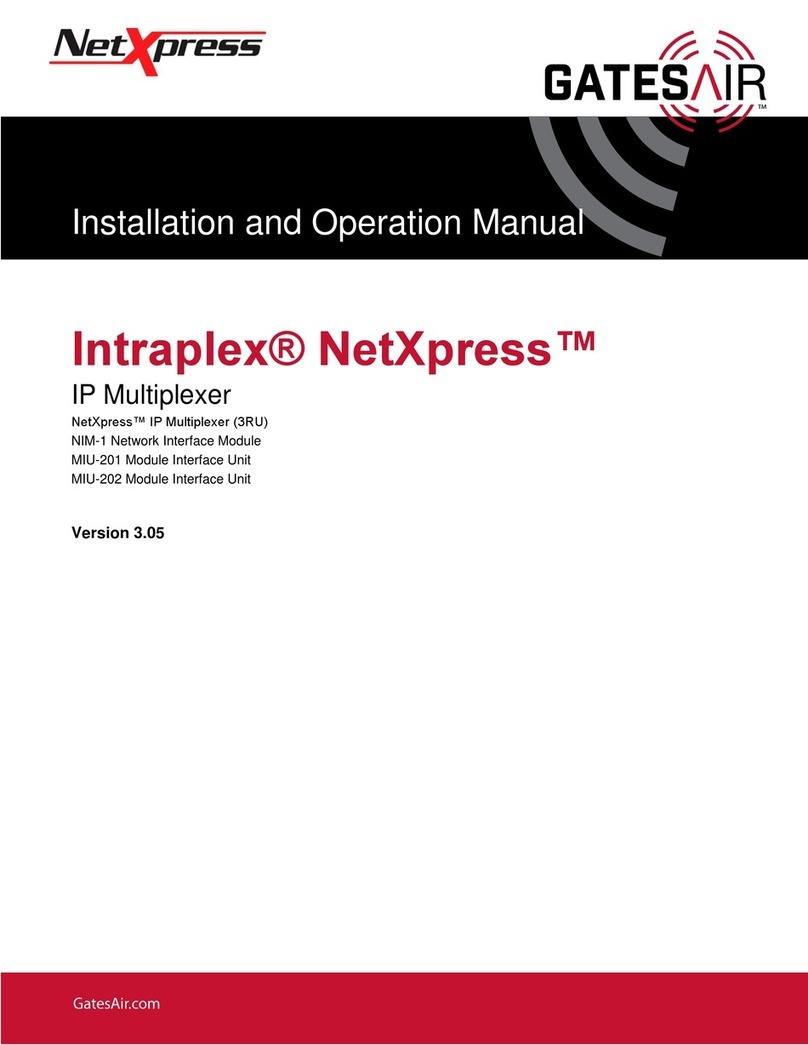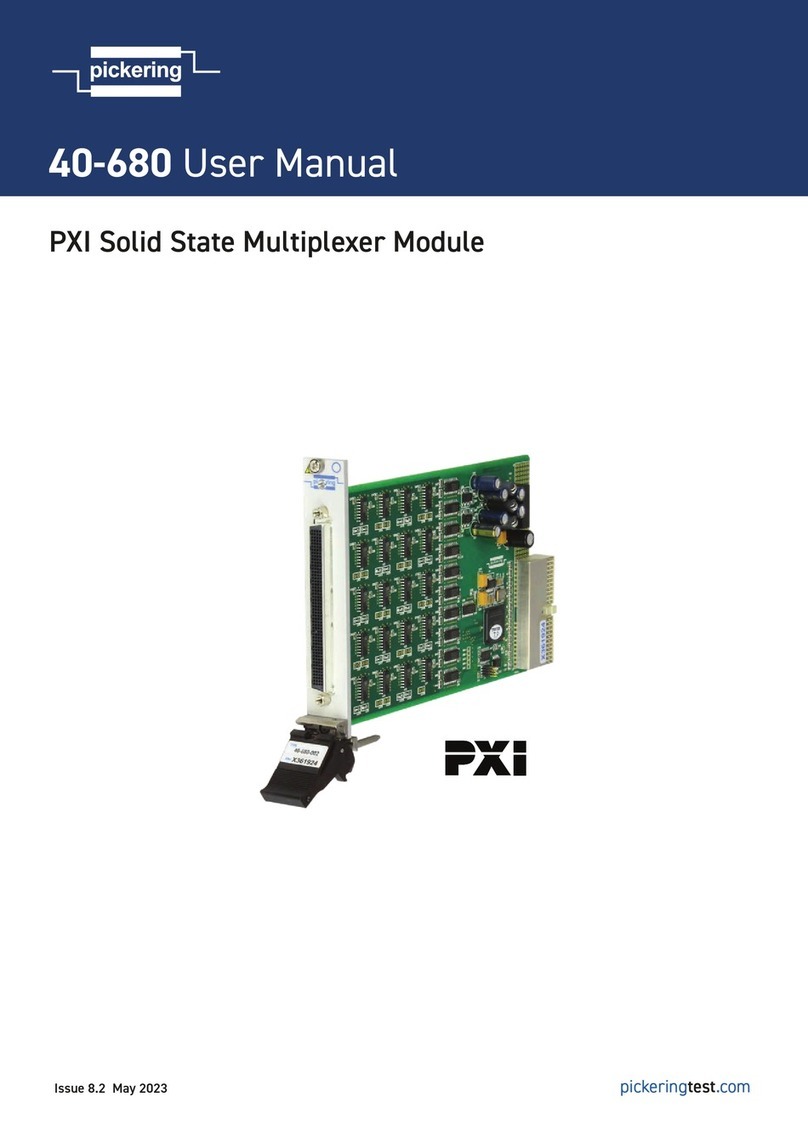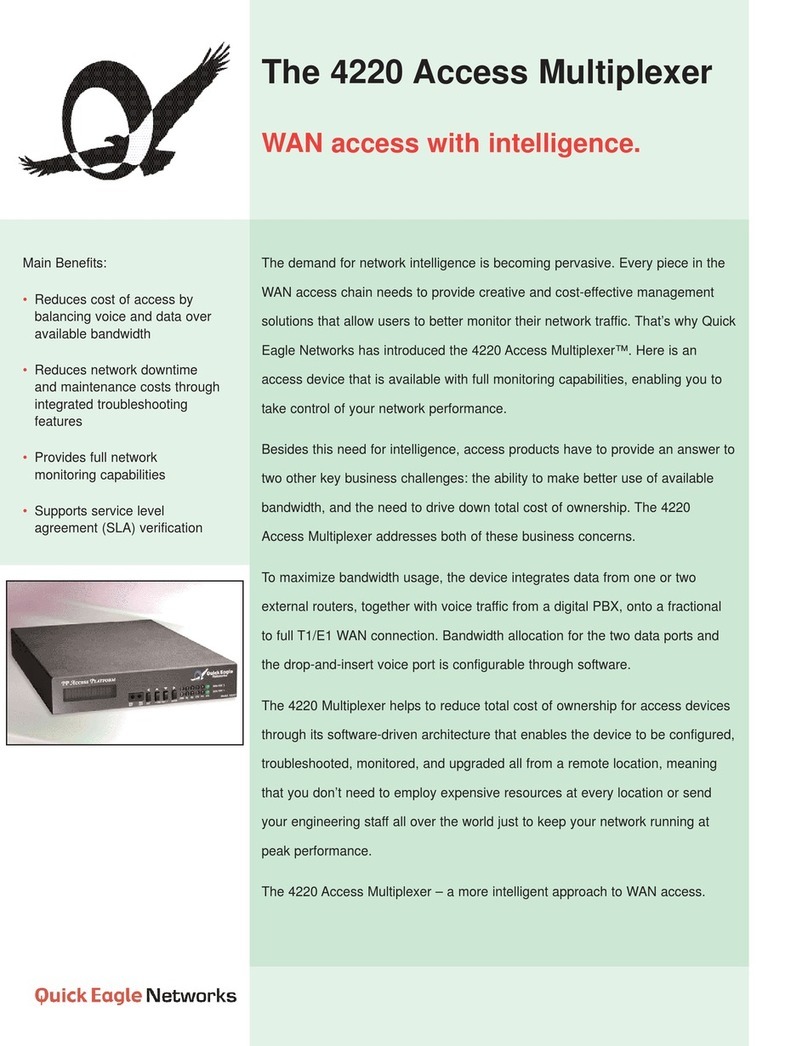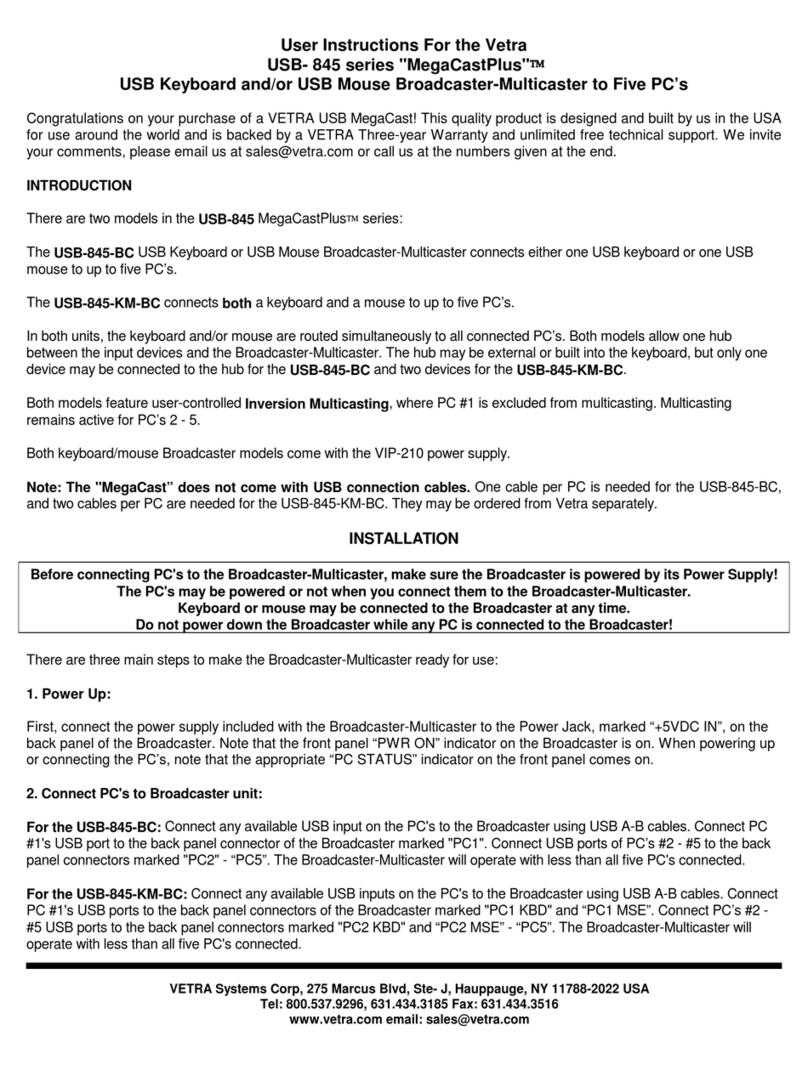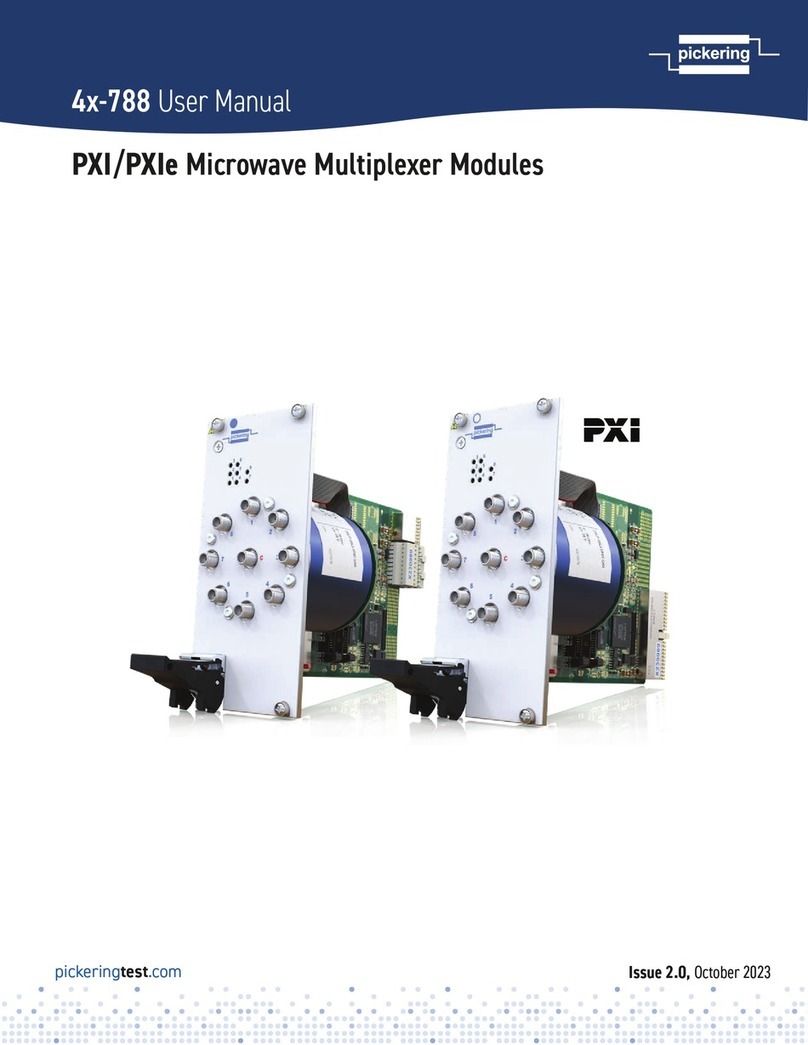GatesAir Intraplex NetXpress LX User manual

GatesAir.com
Intraplex®NetXpress LX™
Audio IP Multiplexer & CM-30R IP Interface Module
NetXpress LX Multiplexer
CM-30R Common Module
MA-230 Module Adapter
MA-231-1/MA-231-2 Module Adapters
Version 1.1
For NetXpress LX Version 1.5
888-5100-040
Installation and Operation Manual

Publication Information
©2014-2018 GatesAir, Inc. Proprietary and Confidential.
GatesAir considers this document and its contents to be proprietary and confidential. Except for making a
reasonable number of copies for your own internal use, you may not reproduce this publication, or any part
thereof, in any form, by any method, for any purpose, or in any language other than English without the written
consent of GatesAir. All others uses are illegal.
This publication is designed to assist in the use of the product as it exists on the date of publication of this manual,
and may not reflect the product at the current time or an unknown time in the future. This publication does not in
any way warrant description accuracy or guarantee the use for the product to which it refers.
GatesAir reserves the right, without notice to make such changes in equipment, design, specifications,
components, or documentation as progress may warrant to improve the performance of the product.
GatesAir reserves the right, without notice to make such changes in equipment, design, specifications,
components, or documentation as progress may warrant to improve the performance of the product.
Trademarks
AudioLink PLUS™, HD Link™, IntraGuide®, Intraplex®, NetXpress™, NetXpress LX™, STL PLUS®, SynchroCast®, and
SynchroCast3™ are trademarks of GatesAir Corporation. Other trademarks are the property of their respective
owners.
Customer Service Contact Information
www.gatesair.com
GatesAir
3200 Wismann Lane
Quincy, Il 62305 USA
For Technical Support including Service, Training, Repair and Service Parts:
www.gatesair.com/services/technical-support
Americas:
24/7 Technical Support +1 217 222 8200
Europe, Middle East and Africa:
24/7 Technical Support +1 217 222 8200
Asia:
24/7 Technical Support +1 217 222 8200

No header
GatesAir, Inc. i
Intraplex Products
Table of Contents
Section 1 –Introduction................................................................ 1-1
1.1Key Features .................................................................................... 1-1
1.2Manual Use ...................................................................................... 1-1
1.3Manual Scope ................................................................................... 1-2
1.4Components..................................................................................... 1-2
1.4.1 Main Equipment Shelf ............................................................................1-2
1.4.2 CM-30R IP Interface Module....................................................................1-3
1.4.3 MA-230 Module Adapter .........................................................................1-3
1.4.4 MA-231-1 / MA-231-2 ............................................................................1-3
1.4.5 Other Modules and Module Adapters ........................................................1-3
1.4.6 Indicator Lights .....................................................................................1-3
1.5 Web Browser User Interface .............................................................. 1-4
Section 2 –Functional Design........................................................ 2-1
2.1 Network Concepts and Considerations ................................................. 2-1
2.1.1 MTU throughout the Network...................................................................2-1
2.1.2 DHCP Use .............................................................................................2-1
2.1.3 Routing Table Construction .....................................................................2-1
2.1.4 WAN Port Auto-negotiation......................................................................2-2
2.1.5 ICMP Support ........................................................................................2-2
2.1.6 IGMP Multicast ......................................................................................2-2
2.2 Streams........................................................................................... 2-3
2.2.1 Stream Types ........................................................................................2-3
2.2.2 Stream Addressing.................................................................................2-4
2.2.3 Multicast Group Addressing .....................................................................2-4
2.2.4 Telephony .............................................................................................2-5
2.2.5 Echo Cancellation...................................................................................2-5
2.2.6 Packetization and Overhead ....................................................................2-6
2.2.7 Packet Jitter Compensation .....................................................................2-6
2.2.8 Packet/Stream Information Calculation.....................................................2-6
2.2.9 Stream Statistics ...................................................................................2-7
2.3 System Security ............................................................................... 2-7
2.3.1 NetXpress LX Login ................................................................................2-8
2.3.2 Management Protocols on an Interface .....................................................2-8
2.3.3 IP Access List Use ..................................................................................2-8
2.3.4 SNMP Communities................................................................................2-9
2.4 NetXpress LX QoS ............................................................................ 2-9
2.4.1 COS Levels for Stream Data....................................................................2-9
2.4.2 TOS Byte Marking for Outbound Stream Packets .......................................2-9
2.4.3 User-Defined TOS Byte Setting for Outbound SNMP and HTTP Packets .........2-9
2.5 NetXpress LX Internal TDM Busses ..................................................... 2-9
2.5.1 Compatibility with Intraplex TDM Channel Modules ..................................2-10
2.5.2 TDM Channel Loopbacks .......................................................................2-11
2.5.3 TDM Bus Mapping ................................................................................2-11

NetXpress LX & CM-30R Installation & Operation Manual Table of Contents
Version 1.1
ii GatesAir, Inc.
Intraplex Products
2.6 System Time-of-Day....................................................................... 2-12
2.7 System Timing............................................................................... 2-12
2.7.1 Types of System Timing .......................................................................2-12
2.7.2 NetXpress LX Timing Scenarios .............................................................2-13
2.8 NetXpress LX System and FEC ......................................................... 2-17
2.9 Power ........................................................................................... 2-18
2.10 Voice Signaling .............................................................................. 2-18
2.10.1 RBS ...................................................................................................2-19
2.10.2 CAS ...................................................................................................2-19
2.11 Software Download ........................................................................ 2-19
2.12 Configuration Files Backup and Restoration ....................................... 2-19
2.13 Fault Detection and Reporting.......................................................... 2-20
2.13.1 Alarm Hierarchy ..................................................................................2-20
2.13.2 Alarm History ......................................................................................2-20
2.13.3 SNMP Traps Use for Fault Reporting .......................................................2-20
Section 3 –Installation & Wiring................................................... 3-1
3.1 Installation Preparation..................................................................... 3-1
3.1.1 Tools & Cables Required .........................................................................3-1
3.1.2 Equipment Unpacking & Inspection ..........................................................3-1
3.2 Installation...................................................................................... 3-2
3.2.1 Shelf Installation ...................................................................................3-2
3.2.2 CM-30R Module Kit Installation................................................................3-2
3.2.3 Channel Module Installation ....................................................................3-8
3.2.4 Power Supply Installation .....................................................................3-10
3.3 Wiring & External Connections ......................................................... 3-10
3.4 Power Application........................................................................... 3-16
Section 4 –Configuration & Operation .......................................... 4-1
4.1 Download Current Software................................................................ 4-1
4.2 Configuration Process ........................................................................ 4-1
4.2.1 Connect and Login to Access NetXpress LX Home Page ...............................4-1
4.2.2 View System Mode .................................................................................4-2
4.2.3 Perform General Setup ...........................................................................4-2
4.3 NetXpress LX Pages ......................................................................... 4-13
4.3.1 Start at the NetXpress LX Home Page.....................................................4-13
4.3.2 Define & Review Fault Information .........................................................4-15
4.3.3 Configure the System...........................................................................4-20
4.3.3.1 General .....................................................................................4-20
4.3.3.2 Contacts ....................................................................................4-22
4.3.3.3 TDM Bus Information ..................................................................4-24
4.3.3.4 TDM Bus Mapping ......................................................................4-26
4.3.3.5 System Timing ...........................................................................4-29
4.3.3.6 Software Images.........................................................................4-30

Table of Contents NetXpress LX & CM-30R Installation & Operation Manual
Version 1.1
GatesAir, Inc. iii
Intraplex Products
4.3.3.7 Configuration Backup and Restore.................................................4-33
4.3.3.8 Redundancy ...............................................................................4-34
4.3.3.9 Site Redundancy .........................................................................4-36
4.3.4 Configure the Network .........................................................................4-39
4.3.4.1 Ethernet Interface .......................................................................4-40
4.3.4.2 Forwarding Table ........................................................................4-42
4.3.4.3 Class of Service ..........................................................................4-44
4.3.4.4 SNMP Configuration.....................................................................4-49
4.3.4.5 UDP Listeners .............................................................................4-50
4.3.4.6 TCP Connections ........................................................................4-51
4.3.4.7 ARP Table .................................................................................4-51
4.3.5 Configure Streams ...............................................................................4-52
4.3.5.1 Stream Creation Dialog................................................................4-54
4.3.5.2 Stream Changes .........................................................................4-61
4.3.5.3 Stream Group.............................................................................4-62
4.3.6 Check Multiplexer Performance..............................................................4-62
4.3.6.1 Stream Statistics.........................................................................4-62
4.3.6.2 Voice Signaling Statistics .............................................................4-64
4.3.6.3 Ethernet Interface Statistics .........................................................4-65
4.3.6.4 SNMP Statistics...........................................................................4-66
4.3.6.5 TCP/UDP Statistics ......................................................................4-67
4.3.6.6 ICMP Statistics............................................................................4-69
4.3.6.7 IGMP Statistics ...........................................................................4-71
4.3.6.8 IP Statistics ................................................................................4-72
4.3.7 Set Up Security ...................................................................................4-74
4.3.7.1 Accounts ....................................................................................4-74
4.3.7.2 IP Access List ............................................................................4-77
4.3.8 Send Echo Requests.............................................................................4-78
4.3.9 Configure CM-30R Module.....................................................................4-78
4.3.9.1 General......................................................................................4-78
4.3.9.2 Revisions ...................................................................................4-80
4.3.9.3 Program Boot ROM ......................................................................4-80
4.3.10 Configure Individual Modules (TDM Modules) ..........................................4-81
4.3.10.1 Sample Program Audio Module....................................................4-82
4.3.10.2 Sample Voice Module .................................................................4-86
4.3.10.3 Sample Data Module ..................................................................4-89
Section 5 –Testing & Troubleshooting ......................................... 5-1
5.1 Testing ........................................................................................... 5-1
5.1.1 General Status Test ...............................................................................5-1
5.1.2 CM-30R Alarm Test ................................................................................5-2
5.1.3 Ping Test ..............................................................................................5-4
5.1.4 Streams Test ........................................................................................5-4
5.2 Troubleshooting ................................................................................ 5-6
5.2.1 Channel Module Addition ........................................................................5-6
5.2.2 Web Browser Interface ...........................................................................5-6
Section 6 –Specifications.............................................................. 6-1
6.1 Detailed Specifications ...................................................................... 6-1
6.1.1 NetXpress LX IP Multiplexer ....................................................................6-1

NetXpress LX & CM-30R Installation & Operation Manual Table of Contents
Version 1.1
iv GatesAir, Inc.
Intraplex Products
6.1.2 CM-30R IP Interface Module....................................................................6-3
6.2 Notice of FCC Compliance.................................................................. 6-5
Appendix A –T1/E1-to-NetXpress LX Multiplexer Conversion ....... A-1
A.1 Installation Preparation.....................................................................A-1
A.1.1 Equipment Unpacking & Inspection ......................................................... A-1
A.1.2 Card Slot Selection ............................................................................... A-1
A.2 IP Multiplexer Conversion..................................................................A-2
A.2.1 CM-30R & MA-230 Installation into the First Multiplexer ............................ A-2
A.2.2 First CM-30R IP Interface Module Configuration ........................................ A-4
A.2.3 CM-30R & MA-230 Installation into the Second Multiplexer ........................ A-4
A.2.4 Second CM-30R IP Interface Module Configuration.................................... A-4
A.2.5 Configuration of Both CM-30R Modules to Work Together .......................... A-5
A.2.6 Removal of the Original Common Modules ............................................... A-6

Table of Contents NetXpress LX & CM-30R Installation & Operation Manual
Version 1.1
GatesAir, Inc. v
Intraplex Products
Figures
Figure 1-1. NetXpress LX-300 / LXR-300 Front Panel with Cover ..................................1-2
Figure 1-2. NetXpress LX-100 / LXR-100 Front Panel with Cover ..................................1-2
Figure 2-1. Carrier Multicast Backbone Example.........................................................2-5
Figure 2-2. NetXpress LX Web Interface Login ...........................................................2-8
Figure 2-3. TDM Loopback Scenarios ......................................................................2-11
Figure 2-4. Timing Synchronization ........................................................................2-14
Figure 2-5. Point-to-Point Timing Synchronization ....................................................2-14
Figure 2-6. Stream Timing Synchronization .............................................................2-15
Figure 2-7. Streams with Different Synchronization Sources ......................................2-15
Figure 2-8. Timing Synchronization with GPS...........................................................2-16
Figure 2-9. Timing with Off-Air Monitor Streams ......................................................2-17
Figure 3-1. NetXpress LX 1RU and 3RU Multiplexers ...................................................3-2
Figure 3-2. CM-30R Module and Indicator Lights ........................................................3-3
Figure 3-3. Contact Input Circuitry ...........................................................................3-5
Figure 3-4. MA-230 Module Adapter Top and Faceplate Views......................................3-6
Figure 3-5. MA-230 Connectors with Indicator Lights ..................................................3-7
Figure 3-6. MA-231-1 / MA-231-2 Connectors ...........................................................3-8
Figure 3-7. CM-30R Module and MA-230 Midplane Insertion ........................................3-8
Figure 3-8. 3RU NetXpress LX Rear Panel Connectors with MA-230 Module Adapter......3-10
Figure 3-9. 1RU NetXpress LX Rear Panel Connectors with MA-230 Module Adapter......3-10
Figure 3-10. Connection for DC Operation of 3RU Systems..........................................3-12
Figure 3-11. Connection for DC Operation of 3RU Systems with Two Power Sources.......3-12
Figure 3-12. Connection for AC Operation of 3RU System with External Signal Battery ...3-13
Figure 3-13. Connection for AC Operation of 1RU System with External Signal Battery ...3-13
Figure 3-14. 3RU Multiplexer Rear Panel with ACS-OPT1 Dual AC Power Feed Option .....3-14
Figure 4-1. Intraplex NetXpress LX Home Page ..........................................................4-2
Figure 4-2. Networking | Forwarding Table................................................................4-3
Figure 4-3. Forwarding Table | Create a New Route Dialog Box ....................................4-4
Figure 4-4. Security | IP Access List .........................................................................4-4
Figure 4-5. IP Access List | Create IP Access List Entry Dialog Box ...............................4-5
Figure 4-6. System Cfg | TDM Bus Information ..........................................................4-5
Figure 4-7. System Cfg | Software Images Configuration ............................................4-6
Figure 4-8. Streams ...............................................................................................4-7
Figure 4-9. Stream Creation –Stage 1 .....................................................................4-7
Figure 4-10. Stream Creation –Stage 2 .....................................................................4-8
Figure 4-11. Stream Creation –Stage 3 for Multi-Unicast .............................................4-8
Figure 4-12. Stream Creation –Stage 4 (TDM to IP) ....................................................4-9
Figure 4-13. Stream Creation Summary ...................................................................4-10
Figure 4-14. System Cfg | System Timing.................................................................4-11
Figure 4-15. Networking | SNMP Configuration ..........................................................4-12
Figure 4-16. System Cfg | Configuration Files Backup/Restore.....................................4-13
Figure 4-17. Intraplex NetXpress LX Home Page ........................................................4-14
Figure 4-18. Current Alarms Page ............................................................................4-16
Figure 4-19. Alarm Definitions Page .........................................................................4-17
Figure 4-20. Specific Alarm Definition Dialog Box .......................................................4-17
Figure 4-21. Alarm History Page ..............................................................................4-18
Figure 4-22. System Logging Page ...........................................................................4-19
Figure 4-23. General Setup Page .............................................................................4-21
Figure 4-24. Contacts Page .....................................................................................4-22
Figure 4-25. Configure Input Contact Dialog Box .......................................................4-23
Figure 4-26. Configure Output Contact Dialog Box .....................................................4-24

NetXpress LX & CM-30R Installation & Operation Manual Table of Contents
Version 1.1
vi GatesAir, Inc.
Intraplex Products
Figure 4-27. TDM Bus Information Page ...................................................................4-24
Figure 4-28. Changes to System Mode Dialog Box .....................................................4-25
Figure 4-29. TDM Bus Configuration Page ................................................................4-25
Figure 4-30. TDM Bus Map Configuration Page –T1 Mode ..........................................4-27
Figure 4-31. Edit TDM Bus Map Configuration Page....................................................4-28
Figure 4-32. System Timing Page............................................................................4-29
Figure 4-33. Software Images Page ........................................................................4-31
Figure 4-34. Configuration Files Backup/Restore Page ...............................................4-33
Figure 4-35. Ethernet Interfaces Page –WAN and LAN Interfaces ...............................4-41
Figure 4-36. Forwarding Table ................................................................................4-43
Figure 4-37. Add a Route Dialog Box .......................................................................4-44
Figure 4-38. DiffServ Marking for Forwarded Packets Page .........................................4-45
Figure 4-39. Add a DiffServ Marking Entry Dialog Box ...............................................4-46
Figure 4-40. DiffServ TOS to Priority Mapping Page ...................................................4-47
Figure 4-41. Map TOS Value to Priority Level Dialog Box ............................................4-47
Figure 4-42. TOS Byte Configurations Page ..............................................................4-48
Figure 4-43. SNMP Configuration Page ....................................................................4-49
Figure 4-44. UDP Listeners Table ............................................................................4-50
Figure 4-45. TCP Connections Table ........................................................................4-51
Figure 4-46. ARP Table ..........................................................................................4-52
Figure 4-47. Streams Table....................................................................................4-53
Figure 4-48. Stream Creation –Stage 1 –Stream Type .............................................4-54
Figure 4-49. Stream Creation –Stage 2 –Stream Features........................................4-55
Figure 4-50. Stream Creation –Stage 3 –IP Parameters ...........................................4-56
Figure 4-51. Stream Creation –Stage 3 –IP Config for All Streams (Multi-Unicast).......4-57
Figure 4-52. Stream Creation –Stage 4 –TDM Bus Parameters..................................4-58
Figure 4-53. Stream Creation Summary Page...........................................................4-60
Figure 4-54. Stream Edit Pages ..............................................................................4-61
Figure 4-55. Stream Statistics Page ........................................................................4-63
Figure 4-56. Performance History Page....................................................................4-63
Figure 4-57. Voice Signaling Statistics Page .............................................................4-64
Figure 4-58. Ethernet Interface Statistics Page –WAN and LAN ..................................4-65
Figure 4-59. SNMP Performance Page......................................................................4-66
Figure 4-60. TCP/UDP Performance Page .................................................................4-68
Figure 4-61. ICMP Performance Page.......................................................................4-70
Figure 4-62. IGMP Performance Page ......................................................................4-72
Figure 4-63. IP Performance Page ...........................................................................4-73
Figure 4-64. Web Interface User Accounts Page ........................................................4-75
Figure 4-65. Add User Account Dialog Box ...............................................................4-76
Figure 4-66. Edit User Account Dialog Box ...............................................................4-76
Figure 4-67. IP Access List Page .............................................................................4-77
Figure 4-68. Add an IP Address Dialog Box ..............................................................4-77
Figure 4-69. Ping Utility Page .................................................................................4-78
Figure 4-70. CM-30R Common Module: General Page ................................................4-79
Figure 4-71. CM-30R Common Module: Revisions Page ..............................................4-80
Figure 4-72. CM-30R Common Module: Program Boot ROM Page ................................4-81
Figure 4-73. DS-64NC Configuration Page................................................................4-82
Figure 4-74. DS-64NC Status Page .........................................................................4-82
Figure 4-75. PT-353 Configuration Page...................................................................4-82
Figure 4-76. PT-353 Status Page ............................................................................4-84
Figure 4-77. VF-25E Configuration Page ..................................................................4-86
Figure 4-78. VF-25E Status Page ............................................................................4-87
Figure 4-79. DS-64NC Configuration Page ................................................................4-89

Table of Contents NetXpress LX & CM-30R Installation & Operation Manual
Version 1.1
GatesAir, Inc. vii
Intraplex Products
Figure 4-80. DS-64NC Status Page ..........................................................................4-91
Figure 5-1. NetXpress LX 3RU Multiplexer –Front View, Closed ..................................5-1
Figure 5-2. NetXpress LX Web Interface Home Page ..................................................5-2
Figure 5-3. Faults | Current Alarms Table.................................................................5-3
Figure 5-4. Faults | Alarm History Log .....................................................................5-3
Figure 5-5. Ping Utility ...........................................................................................5-4
Figure 5-6. Performance | Streams Statistics Table ...................................................5-5
Figure A-1. CM-30R Module and MA-230 Midplane Insertion ...................................... A-2
Tables
Table 2-1. NetXpress LX Stream User and Computed Parameters ..................................2-7
Table 2-2. NetXpress LX-supported TDM Channel Modules ..........................................2-10
Table 2-3. NetXpress LX FEC Performance Data.........................................................2-18
Table 3-1. CM-30 Indicator Light Descriptions .............................................................3-4
Table 3-2. CM-30 Switch Settings ..............................................................................3-4
Table 3-3. MA-230 Module Adapter SW1 Switches and Functions...................................3-6
Table 3-4. MA-230 In/Out and Contact Port Pin Assignments ........................................3-7
Table 3-5. Power and Alarm Connectors ...................................................................3-12
Table 4-1. TDM Bus Map Profiles .............................................................................4-26
Table 4-2. States Associated with Streams ...............................................................4-54

NetXpress LX & CM-30R Installation & Operation Manual Table of Contents
Version 1.1
viii GatesAir, Inc.
Intraplex Products
This page intentionally left blank.

No header here
GatesAir, Inc. 1-1
Intraplex Products
Section 1 –Introduction
This manual covers both the NetXpress LX IP multiplexer and the CM-30R IP interface module. The
NetXpress LX multiplexer provides convenient provisioning and management tools to enhance
operational efficiency. This IP platform supports both unicast and multicast and is compatible with the
Intraplex NetXpress multiplexer.
The NetXpress LX multiplexer combines the technology of the original NetXpress multiplexer in a
module configuration compatible with Intraplex T1 or E1 systems. The NetXpress LX multiplexer is
available in either a 3RU frame with capacity for up to 17 application modules or a 1RU frame that can
hold five application modules. This multiplexer can work in a simple point-to-point and point-to-
multipoint designs and also as an “edge” device with the NetXpress multiplexer in large, multisite
networks.
While the CM-30R IP interface module operates as the command module in a NetXpress LX
multiplexer, this module can also replace the network interface module in an existing T1 or E1 system,
converting it to IP while utilizing the existing chassis with all its audio, voice, and data modules. With
the CM-30R module, you can easily transition an existing Intraplex T1 or E1 system to cost-effective
IP transmission.
1.1 Key Features
The NetXpress LX system’s features include
●CM-30R IP interface module, which can convert existing T1 or E1 systems to IP
●Compatibility with Intraplex NetXpress systems
●Wide variety of audio, voice, and data interface modules
●Optional echo cancellation for 2-wire voice circuits
●Transport of two contact closures in each direction
●Adjustable packet size
●Programmable jitter buffer depth
●Advanced Intraplex forward error correction
●Quality of Service (QoS) priority tagging
●Unidirectional or bidirectional unicast streaming
●Unidirectional multicast streaming
●Web browser user interface
●SNMP control
●Current and previous software revision storage
●Network statistics monitoring
●Event logging
●Optional module redundancy, when used with MA-231-1/MA-231-2
1.2 Manual Use
Use this manual as the primary reference document for installing, configuring, operating, and
troubleshooting the NetXpress LX multiplexer and the CM-30R IP interface module. If you have
additional questions pertaining to the operation of your Intraplex system, you can contact GatesAir
Customer Service:
●U.S., Canada, and Latin America: +1-217-222-8200 or [email protected]
●Europe, Middle East, and Africa: +44-118-964-8100 or [email protected]
●Asia and Pacific Rim: +852-2776-0628 or [email protected]

NetXpress LX & CM-30R Installation & Operation Manual 1 –Introduction
Version 1.1
1-2 GatesAir, Inc.
Intraplex Products
1.3 Manual Scope
The “Table of Contents”helps you locate specific topics. These guidelines give general information on
manual sections.
●Readers unfamiliar with the NetXpress LX system and/or the CM-30R IP interface
module –Use this manual as a tutorial. Read or skim all sections in order.
●Installers –If you are already familiar with the NetXpress LX system and/or the CM-30R IP
interface module, finish reading this section and go directly to Section 3 –“Installation & Wiring”
for step-by-step installation instructions.
●Transmission and Planning Engineers –The NetXpress LX and CM-30R operation and
configuration overview is in Section 2 –“Functional Design,” and specific instructions are in
Section 4 –“Configuration & Operation.” You can find output, power, and other specification
information in Section 6 –“Specifications.”
●Maintenance Technicians –Section 5 –“Testing & Troubleshooting” discusses system tests and
troubleshooting solutions. Individual channel module setup and test procedures can be found in
the manuals for the modules shipped with your system.
1.4 Components
1.4.1 Main Equipment Shelf
The NetXpress LX chassis has two rack-mount equipment sizes:
●NetXpress LX-300 and LXR-300 –19-inch wide, 5 ¼-inch high 3RU (Figure 1-1)
●NetXpress LX-100 and LXR-100 –19-inch wide, 1 ¾-inch high 1RU (Figure 1-2)
Figure 1-1. NetXpress LX-300 / LXR-300 Front Panel with Cover
Figure 1-2. NetXpress LX-100 /LXR-100 Front Panel with Cover
Each LX-100 and LX-300 shelf is equipped with a CM-30R module, an MA-230 module adapter, and
slots for plug-in channel modules and module adapters.
Each LXR-100 and LXR-300 contains two CM-30R modules, an MA-231-1 module adapter and an MA-
231-2 module adapter.
The NetXpress LX-100 and LXR-100 multiplexer has a single built-in AC power supply.
The LX-300 and LXR-300 multiplexer has a single plug-in AC or DC power supply and optional
secondary plug-in AC or DC supplies. Dual AC-input option is also available.

1 –Introduction NetXpress LX & CM-30R Installation & Operation Manual
Version 1.1
GatesAir, Inc. 1-3
Intraplex Products
1.4.2 CM-30R IP Interface Module
The CM-30R module is the command center for the NetXpress LX IP multiplexing system. This module
acts as an IP network interface, a packet engine, and a system manager. When coupled with the MA-
230 module adapter (Section 1.4.3), the CM-30R module provides shelf management control, WAN
and LAN traffic control through 10/100Base-T ports, and timing control for external stream traffic and
system synchronization. When used with the MA-231-1 and MA-231-2 module adapter pair (Section
1.4.4), full hardware redundancy of the network controller is achieved.
You can use a CM-30R module in place of, but not at the same time as, a T1 or E1 common module
(CM-3, CM-5, CM-5RB, CM-6, CM-7, or CM-7RB) in an existing Intraplex T1 or E1 multiplexer. You can
then revert back to T1 or E1 at a later date by simply removing the CM-30R module and reinserting
the original common module.
1.4.3 MA-230 Module Adapter
The MA-230 module adapter provides connectivity for the CM-30R module. The MA-230 module
adapter connects to the CM-30R module in the rear of the shelf and features these communication
ports:
●Two 10/100Base-T ports (WAN and LAN)
●Timing in/out for external stream and system synchronization
●Contact I/O for external control
1.4.4 MA-231-1/MA-231-2
The module adapter pair MA-231-1/MA-231-2 provides support for CM-30R module redundancy. Each
of these two modules adapters offer:
●Two 10/100Base-T ports (WAN and LAN)
●A communication bridge to the companion CM-30R
●Contact I/O is provided on the MA-231-1.
●The Timing input and output connections is available on the MA-231-2.
1.4.5 Other Modules and Module Adapters
The NetXpress LX system offers five channel card slots (1RU shelf) or 17 channel card slots (3RU
shelf) for Intraplex audio, voice, and data modules, and redundant controllers.
Intraplex module adapters are installed in the rear of the shelf and work in conjunction with the
channel access cards installed in the front.
1.4.6 Indicator Lights
Four system status indicator lights located on the NetXpress LX power supply are visible when the
front shelf cover is on (Figures 1-1 and 1-2).
●POWER –This green light is on when the multiplexer is powered.
●NORMAL –This green light is on when no major nor minor alarm is present.
●ALERT –This yellow light is on when a minor alarm condition exists.
●ALARM –This red light is on when a major alarm condition exists.
Section 5 defines major and minor alarm conditions.
The CM-30R module has indicator lights as well, which are visible when the front shelf cover is
removed. Section 3.2.2 gives more information about CM-30R indicator lights.

NetXpress LX & CM-30R Installation & Operation Manual 1 –Introduction
Version 1.1
1-4 GatesAir, Inc.
Intraplex Products
1.5 Web Browser User Interface
You can control functionality of your NetXpress LX unit and access network statistics and system
status through the NetXpress LX Home page. You can choose to run simultaneous software windows;
each connected to a different NetXpress LX system in the network.
The Web browser interface, in conjunction with an SNMP network manager, lets you control and
monitor your system using your network management system. Accessing the Home page provides a
more comprehensive or systemic view from which to research a particular problem or obtain a
graphical view of system configuration or status.
Section 4 –“Configuration & Operation” gives more information on this interface software.

No header here
GatesAir, Inc. 2-1
Intraplex Products
Section 2 –Functional Design
This section describes the intent of IP multiplexing and day-to-day operations of the NetXpress LX
system and the CM-30R IP interface module. The section also describes how to use the IP multiplexer
and interface module to configure real-time payload transport of audio and data over existing IP
networks.
Packet-based media transport with the NetXpress LX system or the CM-30R module provides these
features:
●Transport of audio, voice, data, and video
●Flexibility when integrating to business applications, systems, and networks
●Network monitoring
●Error mitigation
●Transition and migration from legacy systems with reuse of modules and components
2.1 Network Concepts and Considerations
When looking at the NetXpress LX system (or the CM-30R module) and packet-switched services as a
whole, consider these network-related concepts:
●MTU throughout the network
●DHCP use
●Routing table construction
●WAN port auto-negotiation
●ICMP support
●Redundant WAN link configuration
●IGMP multicast
2.1.1 MTU throughout the Network
Prior to configuring a stream, you need to know end-to-end MTU (Maximum Transmission Unit)
between stream endpoints, which you can measure using an external server or router and running the
“Path MTU” tool. The stream payload must be smaller than the path MTU, otherwise fragmentation
occurs, the stream does not come up, and the NetXpress LX system does not support re-assembly.
2.1.2 DHCP Use
Dynamic Host Configuration Protocol (DHCP) is a network protocol that enables a DHCP server to
automatically assign an IP address to an individual computer’s IP network interface. DHCP dynamically
assigns a number from a defined range of numbers configured for a given network.
The NetXpress LX system supports dynamic address assignment for its LAN interface using DHCP. On
the WAN interface, only static IP address assignment is supported. You can elect to enable the DHCP
option for the management interface from the Networking Ethernet Interfaces Web page (Section
4.3.4 –Configure the Network). If DHCP is enabled and the system fails to successfully retrieve an IP
address, it defaults to the factory default address –192.168.1.1.
2.1.3 Routing Table Construction
The behavior of the NetXpress LX system within the customer’s network is that of an IP host. As such,
the NetXpress LX routing table is used solely to route internally generated packets. For streams that
are unicast, the determination of the next-hop gateway to reach the remote NetXpress LX shelf is
done by examining the system routing table.

NetXpress LX & CM-30R Installation & Operation Manual 2 –Functional Design
Version 1.1
2-2 GatesAir, Inc.
Intraplex Products
Routes in the routing table fall into two basic categories: automatic routes and user-defined routes.
The NetXpress LX system adds automatic routes based on the interface IP addresses. These routes
are called “directly connected” routes and are present to identify local subnets. If the destination for
all NetXpress LX traffic (stream and management) is to a host on its local subnet, no user routes are
needed. In most cases, however, you need to add routes to remote networks or hosts so that the
NetXpress LX system can successfully send traffic to it. In the simplest case, if there is only one
gateway on its WAN subnet, a default route (such as 0.0.0.0/0.0.0.0 next-hop “gateway IP”) pointing
to that gateway should be added. You can manage the NetXpress LX routing table from the NetXpress
LX Home page (Section 4.3.4.2 –Forwarding Table) or via direct SNMP access of the proprietary route
management MIB (Management Information Base).
2.1.4 WAN Port Auto-negotiation
The auto-negotiation mechanism accommodates multi-speed Ethernet network devices. Auto-
negotiation occurs when a physical connection is made between a NetXpress LX Ethernet port and an
Ethernet port on a network switch or router. During this process, the two Ethernet devices use a
protocol to determine at what speed (10 Mbps or 100 Mbps) they communicate and whether the
exchange of data occurs in a half-duplex (only one end transmits at a time) or full-duplex manner.
With the NetXpress LX system, you can enable or disable auto-negotiation for the WAN ports because
it is crucial that the link characteristics are set correctly to facilitate the transmission of stream data.
Auto-negotiation should be enabled when the network port to which the NetXpress LX system is being
connected is capable of negotiating to a mode of 100 Mbps or 10 Mbps and full-duplex operation.
When auto-negotiation is disabled, each Ethernet port must be set to operate at 100 Mbps speed in
full-duplex mode, the optimum setting. If the anticipated stream data rate is low enough, the WAN
port can operate effectively at 10 Mbps. Operating the WAN port in half-duplex mode should be
avoided. Both sides of the link need to be set for auto-negotiation. If not, the NetXpress LX system
configures itself for 10 Mbps, half duplex, and streams experience dropped packets due to collision on
the Ethernet link.
The LAN port is always set to auto-negotiate. The management port can satisfy its function even when
operating at 10 Mbps in half-duplex mode.
Note: Do not operate auto-negotiation on only one side of the NetXpress LX network cable
connection. To work properly, both ends (NetXpress LX system and connected networking
device) must be enabled for auto-negotiation. The NetXpress LX system does not revert to
100 Mbps full-duplex if it is configured to auto-negotiate and the other device is manually
configured for 100 Mbps full-duplex.
2.1.5 ICMP Support
The ICMP (Internet Control Message Protocol) delivers error and control messages from hosts to
message requestors. An ICMP test may determine whether a destination is reachable. The ICMP
messages typically report errors in the processing of datagrams. Additionally, ICMP provides flow
control and first-hop gateway redirection. On the NetXpress LX WAN port, there is an option to block
ICMP error messages, but the “ping” messages are always allowed.
2.1.6 IGMP Multicast
The NetXpress LX system (the CM-30R module within the Intraplex system) interoperates with
multicast routers using the Internet Group Management Protocol (IGMP). The IGMP Multicast mode
involves transmission to specific hosts through IGMP routers. This scheme allows you to route specific
packets onto specific segments, thereby segregating unwanted traffic from narrow segments.
The NetXpress LX system supports IGMP v2 messages. When a “receive”multicast stream is
configured, it sends out IGMP membership reports. Similarly, when the multicast streams are deleted,
the NetXpress LX system sends out an IGMP Leave message and responds to membership queries

2 –Functional Design NetXpress LX & CM-30R Installation & Operation Manual
Version 1.1
GatesAir, Inc. 2-3
Intraplex Products
from the router. It supports the proprietary IGMP statistics MIB to account for all incoming and
outgoing messages.
2.2 Streams
The CM-30R IP network interface module within the NetXpress LX multiplexer uses packet streaming
to transport audio and data content of any installed channel modules.
2.2.1 Stream Types
2.2.1.1 Unidirectional versus Bidirectional
Packet streams can be unidirectional or bidirectional. In other words, streams can travel in one
direction (transmitted or received) or two directions (transmitted and received). The CM-30R module
supports both unidirectional and bidirectional packet streaming.
Most circuit types (such as voice and two-way data circuits) are bidirectional, or full-duplex. Full-
duplex circuits require identical full-duplex (transmit or receive) channel modules at both ends of the
channel they occupy within a system. Other circuit types (such as program audio channels) are
unidirectional (simplex). They always have a transmitter module at one end and a receiver module at
the other. Most bidirectional (full-duplex) channel modules can also be set up to operate in a
unidirectional (simplex) mode.
2.2.1.2 Unicast versus Multicast
Packet streams can also be classified as unicast or multicast. Unicast describes transmitting a piece of
information (a packet stream in this case) from one point to another point. Unicast transfer mode is
still the predominant form of transmission on LANs and within the Internet. Standard unicast
applications include HTTP, SMTP, FTP, and Telnet.
Multicast describes communication where a piece of information is sent from one or more points to a
set of other points (a multicast group address). There may be one or more senders and the
information is sent to a set of receivers (there may be no receiver or any number of receivers). With
multicasting, the same packet is delivered simultaneously to a group of clients. Multicast applications
must use the UDP (User Datagram Protocol) transport protocol, since TCP (Transmission Control
Protocol) only supports the unicast mode.
Most circuits provided by Intraplex multiplexer systems are unicast, including those provided with the
NetXpress LX system. However, several types of channel modules can be configured for point-to-
multipoint operation (multicast). For example, you can set up a single program audio transmitter
module and several program audio receiver modules in a point-to-multipoint or “broadcast” circuit
configuration, allowing multiple locations to receive the same program audio signal.
If your network does not support multicasting, you can configure the NetXpress LX system to multi-
unicast up to four destinations. The programming source must be in contiguous time slots on the TDM
Bus. Section 4.3.3.4 –TDM Bus Mapping Configuration gives additional multi-unicast information.
2.2.1.3 Voice Streams versus Data Streams
Streams which are intended to carry information for voice grade audio modules often require
additional signaling information to support pulse dialing, off-hook condition, call progress or ringing
states. Special signaling support is required to transport this added information. Voice audio streams
carrying telephone calls are also prone to audio echo back from the receiver. You can use echo
canceling circuits to eliminate this problem. Streams used for transporting linear or compressed
wideband audio modules or other forms of raw information present their data directly into each
channel and do not require signaling support.

NetXpress LX & CM-30R Installation & Operation Manual 2 –Functional Design
Version 1.1
2-4 GatesAir, Inc.
Intraplex Products
2.2.2 Stream Addressing
The stream addressing process involves designating a destination IP address for unicast or a
destination multicast group for multicast IP streams (Section 4.3.5–Configure Streams). During the
process of adding streams, individual streams are designated as either unicast or multicast in the
Transmission Type field (Section 4.3.5.1 –Stream Creation).
When you create a stream, a UDP port number must be specified for both the local and remote
NetXpress LX devices. The RTP protocol conversation between the two devices takes place through the
specified UDP ports.
The range for UDP port numbers must be greater than or equal to 50000 and a multiple of 5, ending
in either a 0 or a 5. For unicast and multicast receive streams, the combination of peer’s IP address
and source and destination UDP ports must be unique. For multicast transmit streams, each stream
must use a unique port number.
Many networks use a device known as a “firewall” at the entry point to the network to provide security
against hackers and other undesirable applications. Usually, network devices in the private network
behind the firewall can freely transmit out using any UDP port number. However, devices are blocked
from receiving packets using a UDP port number until a packet is transmitted out from the firewall
using the same UDP port. When setting up the network for a NetXpress LX installation, you may need
to configure the firewall to allow communication on the UDP port numbers used for stream traffic
before attempting to placing any streaming service.
2.2.3 Multicast Group Addressing
The CM-30R IP interface module within the NetXpress LX system or NIM-1 in an original Intraplex
NetXpress system, supports multicast use for stream transmission and supports creating up to 32
transmit, receive, or a combination of transmit and receive streams. This system does not make any
restrictions on the type of multicast address used for a stream destination. Therefore, you determine
how you want the multicast address space to be administered. Figure 2-1 represents a scenario where
multicast addresses are “administratively scoped.” However, some customers may also require GLOP
assignment by the carrier WAN, using address ranges 233.x.x.x, and the NetXpress LX system can
accommodate that addressing scheme as well. Section 4.3.5.1 –Stream Creation gives additional
information regarding multicast addresses.

2 –Functional Design NetXpress LX & CM-30R Installation & Operation Manual
Version 1.1
GatesAir, Inc. 2-5
Intraplex Products
Figure 2-1. Carrier Multicast Backbone Example
2.2.4 Telephony
The CM-30R module and NetXpress LX system allows you to create streams whose endpoints are
Intraplex voice channel modules that support telephone signaling (for example, the VF-15E, VF-16AE,
and VF-25 modules). The voice circuits generate signaling bits which the NetXpress LX system
transports out-of-band and reinserts onto the NetXpress LX internal TDM bus at the receive end. No
more than 20 telephony streams are allowed in-service at one time.
Telephony streams can be easily identified in the stream table by the telephone icon after the stream
name. The color of the icon, (red, yellow, or green) indicates the current state of the out-of-band
signaling transfer. The NetXpress LX Performance menu provides statistics on signaling packet
transmission, and these statistics are cleared when the other stream statistics are cleared.
The TDM bus in T1 systems inherently supports signaling. In E1 systems, the signaling bits are carried
on the internal TDM bus using Channel Associated Signaling (CAS). Telephony streams need to
originate and terminate on busses where the CAS mode is enabled. You can select the specific TDM
busses for the telephony streams on the TDM Bus Edit screen (System Config | TDM Bus | TDM
Bus Edit). When the CAS mode is enabled, the NetXpress LX system uses Time slot 16 to carry the
signaling bits for all the other channels on that bus; this time slot is not available to carry normal
traffic.
2.2.5 Echo Cancellation
The NetXpress LX system can provide echo cancellation for voice circuits using up to 2 optional echo
canceller cards that plug onto the CM-30R module. Each board can provide echo cancellation for up to
30 channels per echo canceller card on the TDM bus.
Echo cancellation can only be enabled for full-duplex streams with identical bus/channel configuration
in the transmit (Tx) and receive (Rx) direction, and both endpoints of the stream need to have an
echo canceller card installed. Echo cancellers are needed in 2-wire modules (for example, the VF-15E

NetXpress LX & CM-30R Installation & Operation Manual 2 –Functional Design
Version 1.1
2-6 GatesAir, Inc.
Intraplex Products
or 16AE module) but not in 4-wire modules (for example, the VF-25E module) excepting when a 2-
wire module adapter is also being used.
When using echo cancellation, you should not configure streams to encapsulate more than 60 frames
per packet.
2.2.6 Packetization and Overhead
Packetization is a process in which frames of data from the TDM bus are collected into IP packets for
transmission through the IP network. A frame on a NetXpress LX TDM bus is divided into 32 (E1) or 24
(T1) partitions or time slots, each containing a byte of data. Because of the serial nature of the TDM
bus, an entire TDM bus frame encompasses 125 µS in time. The stream packetization interval defines
the number of TDM frames collected by the NetXpress LX system into a single packet for transmission.
The higher the packetization interval, the greater the accumulation delay introduced to the stream
content because each frame must be accumulated before the packet can be created. Note that the
total stream delay is a combination of packetization delay and network delay.
Each packet in a NetXpress LX stream contains 44 bytes of non-consumer data (overhead)
corresponding to the header information required for the IP, UDP, and RTP protocol layers. The ratio of
non-consumer data to consumer data for a packet can be considered the overhead required to get the
packet through the network. High overhead means that the greater portion of the network bandwidth
available to an application is being used to transmit non-consumer data. Stream delay can be
minimized by using a small packetization interval at the expense of an increase in overhead.
Conversely, increasing the packetization interval decreases the overhead but increases the transport
delay (Table 2-1).
Another overhead determination factor is the number of time slots from each TDM frame that get
placed into each packet. As this number increases, the stream overhead decreases because the ratio
of overhead data to program data decreases. However, the number of time slots consumed from each
frame does not affect the transport delay. Therefore, it is desirable to combine time slots from a TDM
bus headed for the same destination into a single stream to reduce overhead and to make the best
use of available network bandwidth.
2.2.7 Packet Jitter Compensation
In an IP network, the time required for a packet to travel through the network from sender to receiver
is not guaranteed to be maintained. As a result, the receiver can see the interval between the arrival
of packets vary throughout the reception of the packet stream. For a given packet, the difference
between the packet’s delay and the average of the delay values for all packets in the stream is known
as jitter. The jitter can be positive or negative depending on whether the packet delay is less than or
greater than the average delay.
For many network services, packet jitter is not an issue, and no technique is needed to compensate.
However, the continuous playout nature of audio and synchronous data applications requires that
there must be some means of guaranteeing that the receiver always has the next packet of data when
the previous packet is consumed. The receiver must also hold onto packets that arrive early so that
they are available for playout at the proper time.
The NetXpress LX system compensates for stream packet jitter by utilizing a jitter buffer. The system
maintains a jitter buffer for each stream on the receive side. The buffer is sized so that the buffering
delay is greater than the maximum packet delay expected through the network. In the NetXpress LX
system, you specify the jitter buffer size in number of packets ranging from 8 to 128 (Section 4.3.5.1
–Stream Creation). The packetization interval of the stream controls the amount of packet delay for
which the jitter buffer can compensate. Increasing the number of TDM frames contained in a packet
increases the size of the jitter buffer as measured in time.
2.2.8 Packet/Stream Information Calculation
Table 2-1 gives an example of user and computed parameters for a NetXpress LX stream. The user
parameters represent user-defined stream parameters. The computed parameters are for packet
This manual suits for next models
5
Table of contents
Other GatesAir Multiplexer manuals
Popular Multiplexer manuals by other brands
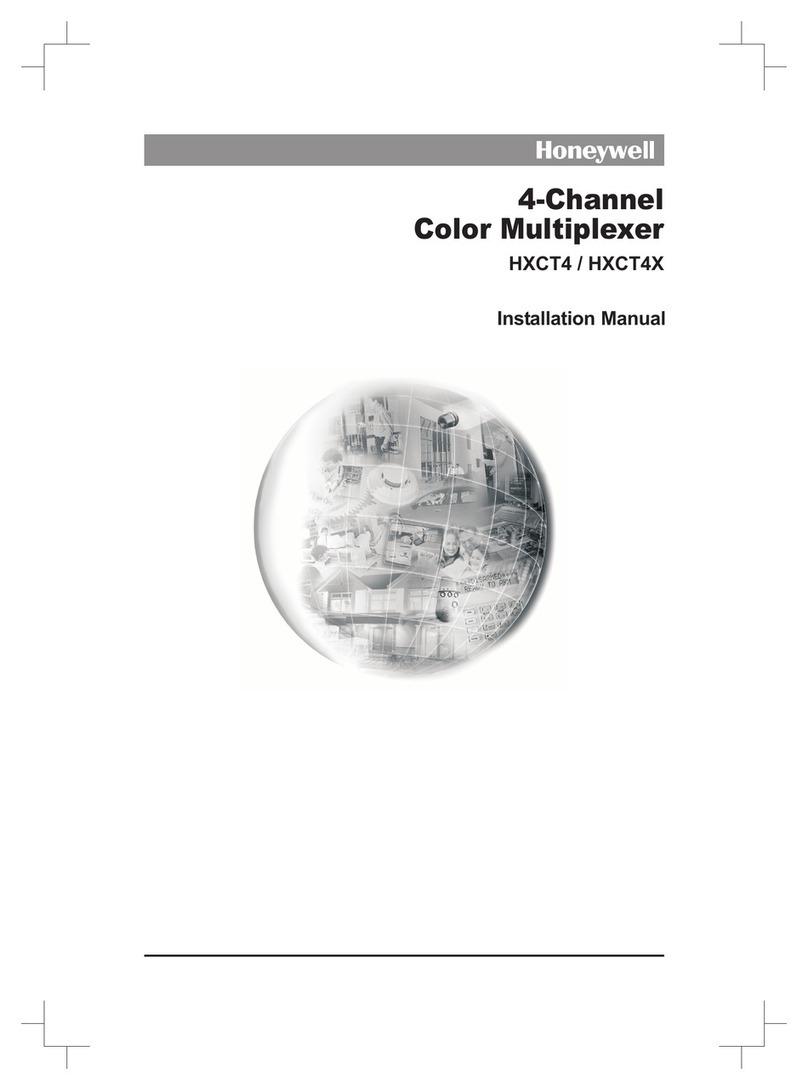
Honeywell
Honeywell HXCT4 installation manual
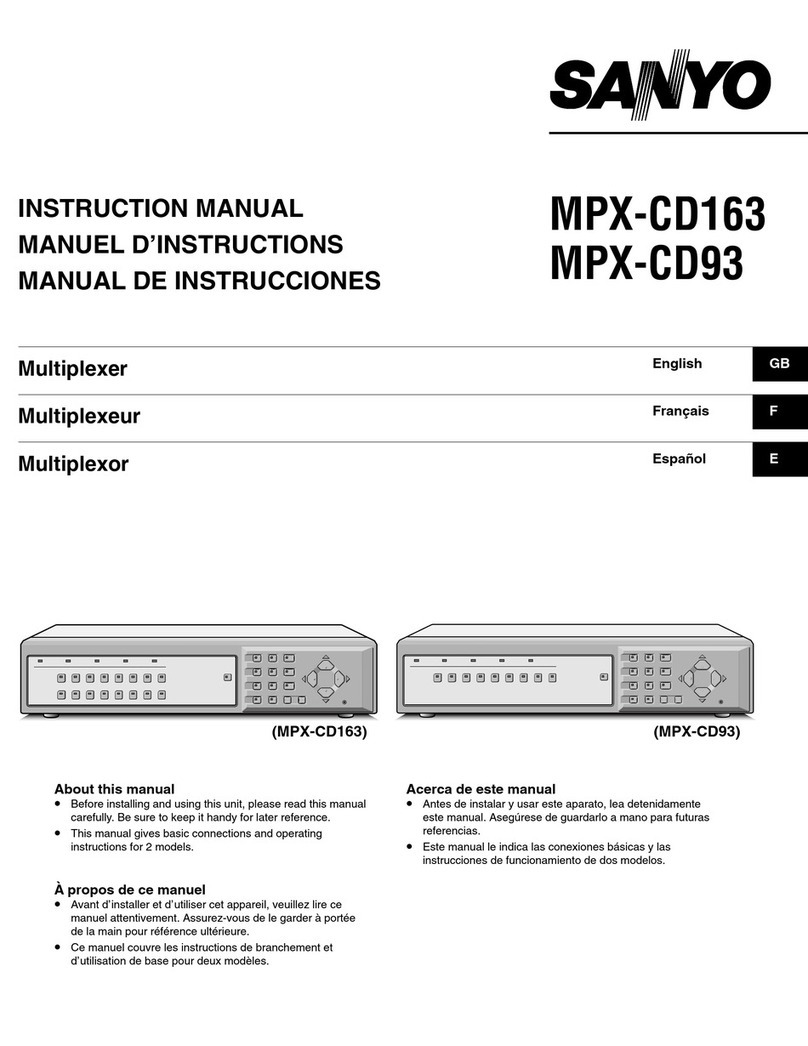
Sanyo
Sanyo MPX-CD163 instruction manual
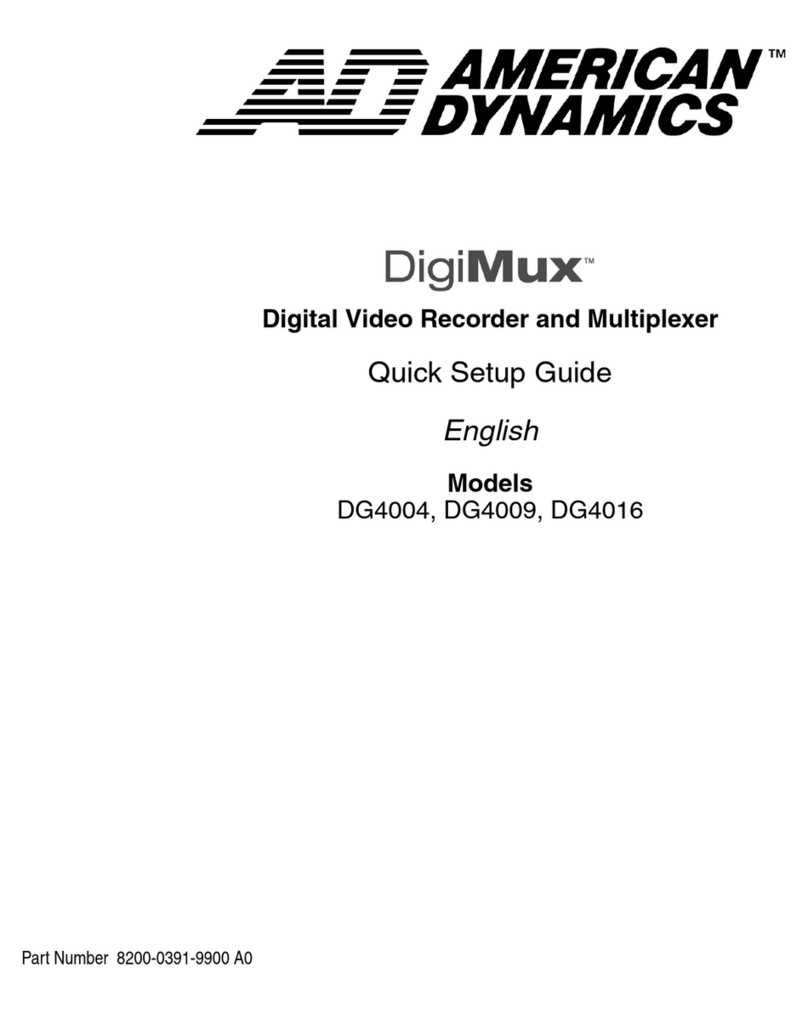
American Dynamics
American Dynamics DigiMux DG4004 Quick setup guide
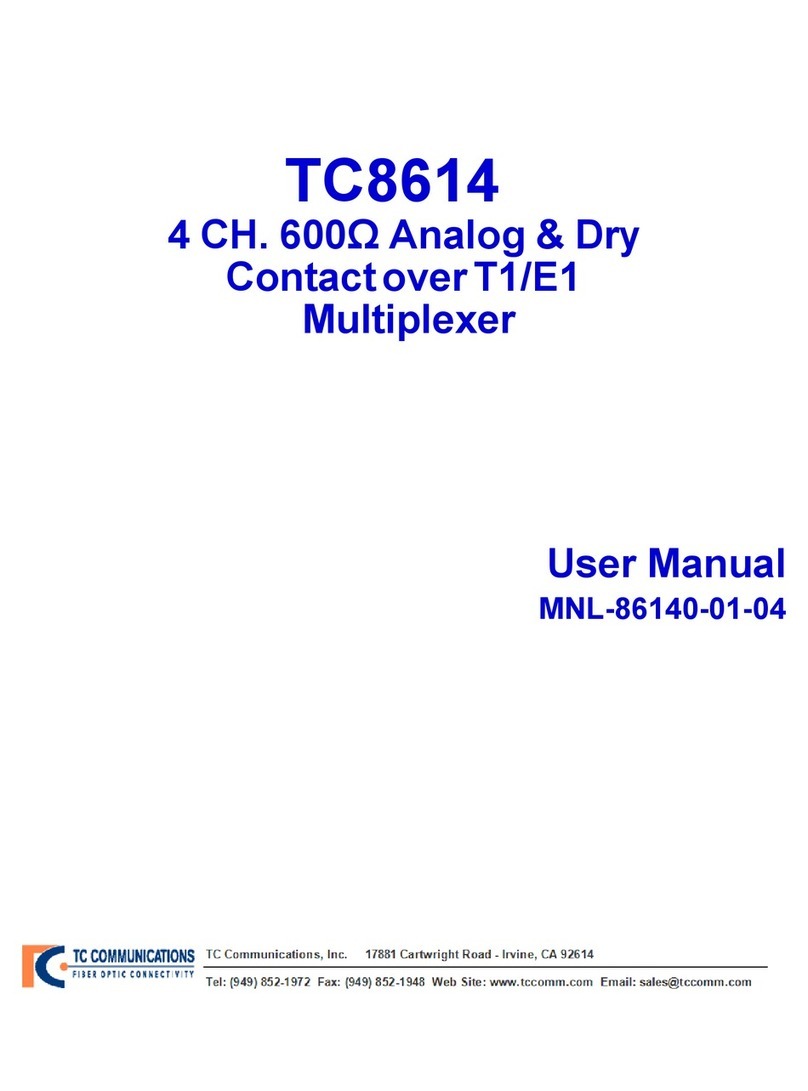
TC Communications
TC Communications TC8614 user manual
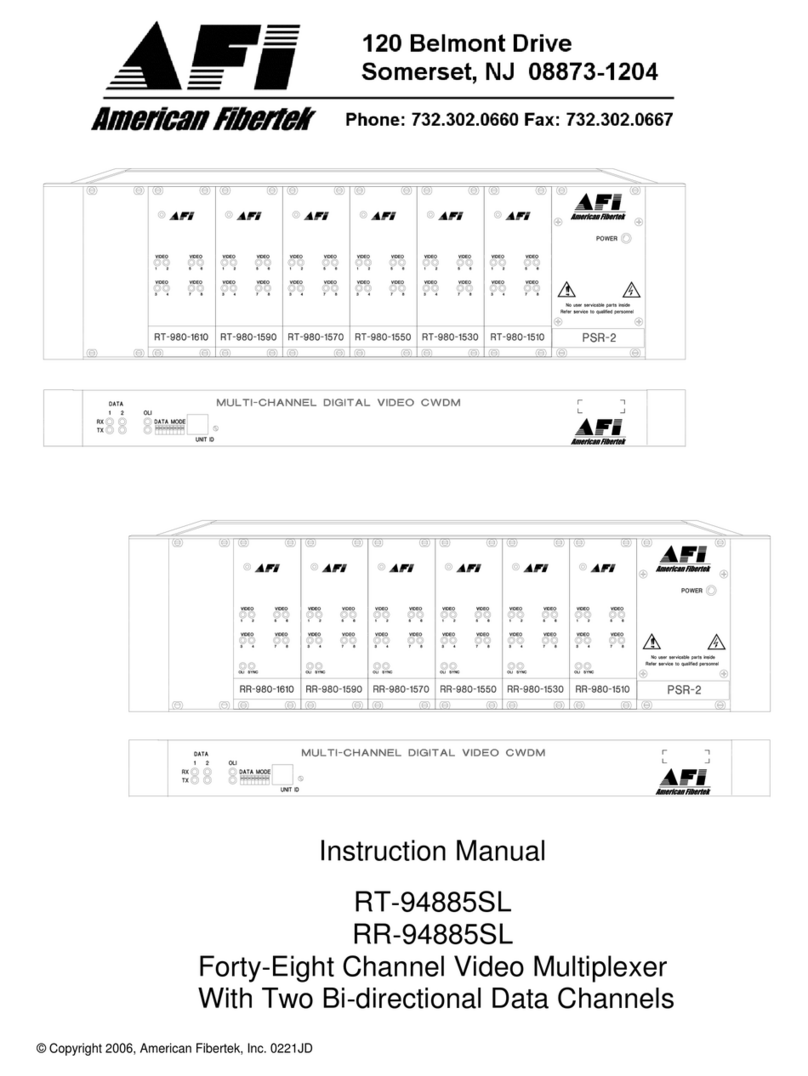
American Fibertek
American Fibertek RT-94885SL instruction manual
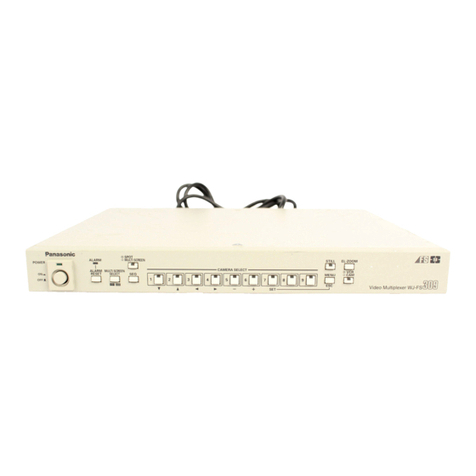
Panasonic
Panasonic WJ-FS309 operating instructions

Agilent Technologies
Agilent Technologies E8462A user manual
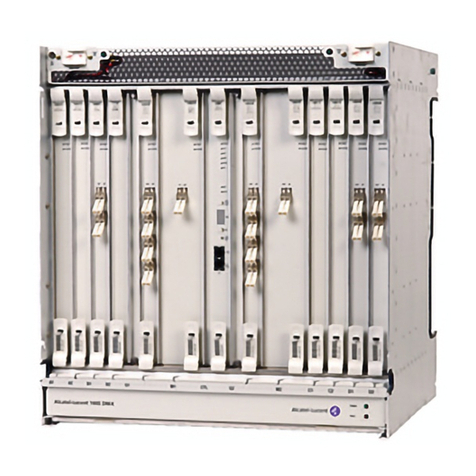
Alcatel-Lucent
Alcatel-Lucent Data Multiplexer Explore 1665 installation manual
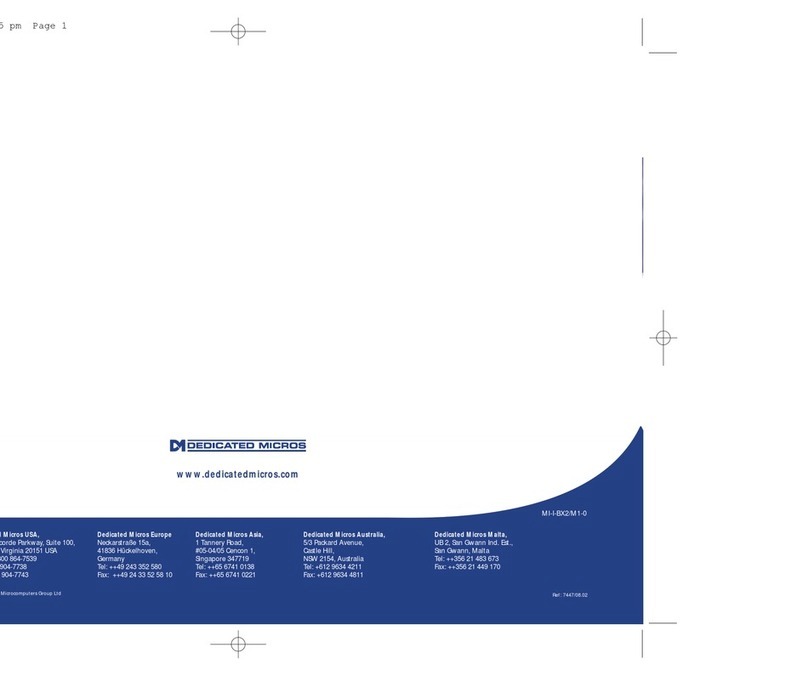
Dedicated Micros
Dedicated Micros BX2 Setup guide

RFS
RFS FD9R6004 Series installation instructions
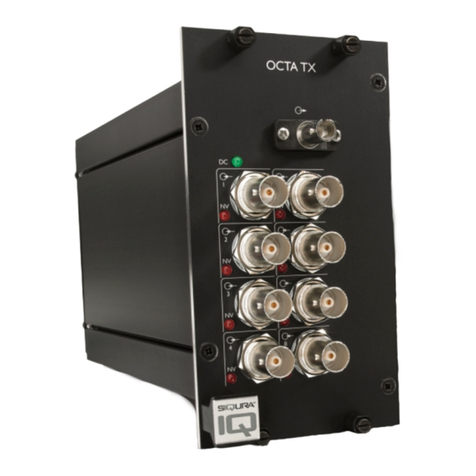
Siqura
Siqura OCTA 40 0 Series user manual
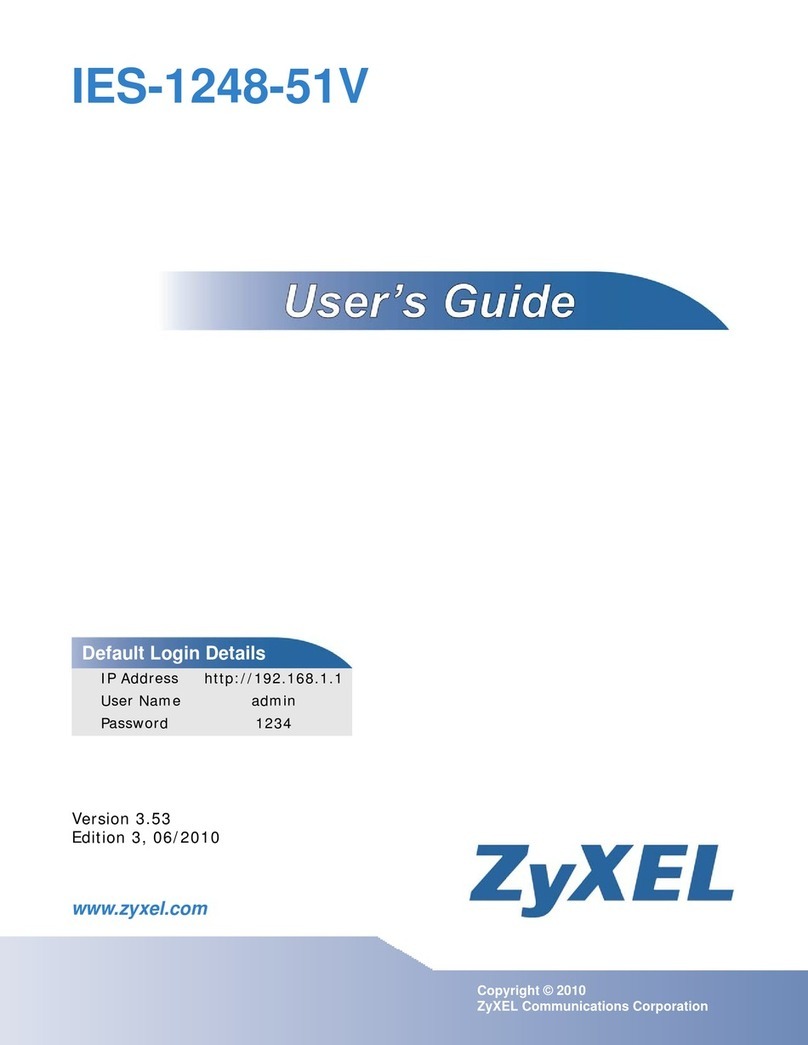
ZyXEL Communications
ZyXEL Communications IES-1248-51A user guide
